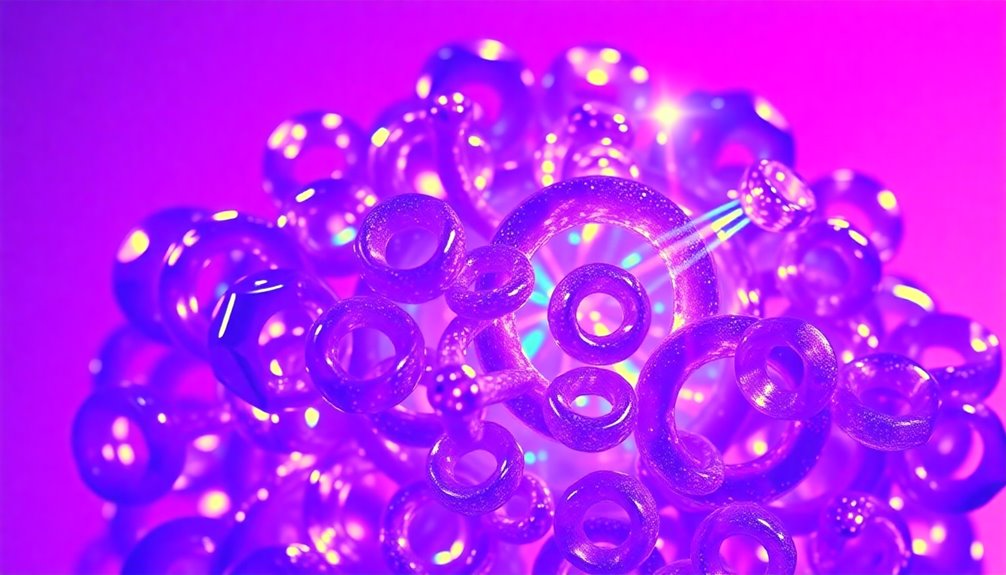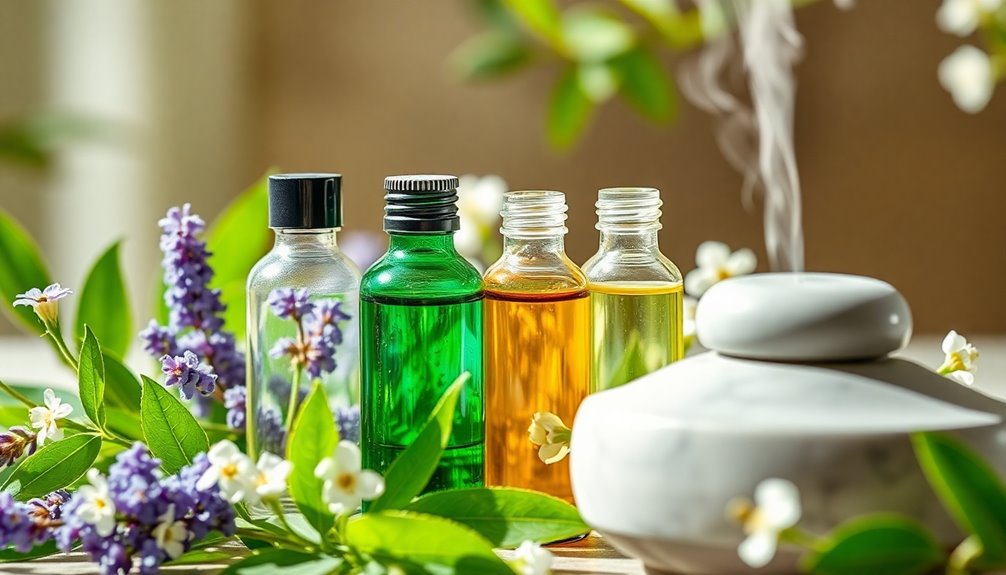Aromatic rings absorb UV light because of their structure and the way their π electrons interact with energy. The carbon atoms in these rings create a system of alternating single and double bonds, allowing for electron delocalization. When UV light hits these rings, it excites the π electrons, enabling them to jump from bonding to anti-bonding orbitals. The degree of conjugation influences how well they absorb light, with larger systems absorbing longer wavelengths. This property is essential in many applications like chromatography. There's much more to explore about their fascinating role in chemistry and photochemical reactions.
Key Takeaways
- Aromatic rings absorb UV light due to delocalized π electrons that can be excited from bonding to anti-bonding orbitals.
- The presence of conjugation in aromatic systems lowers the energy gap between HOMO and LUMO, facilitating UV absorption.
- Larger conjugated systems absorb longer wavelengths of UV light, resulting in characteristic absorption spectra.
- The alternating single and double bonds in aromatic structures enhance stability and promote effective UV light interaction.
- The strong UV absorption of aromatic compounds is crucial for their detection in chromatographic applications.
Structure of Aromatic Rings

Aromatic rings are fascinating structures that play a crucial role in organic chemistry. These rings, like benzene, consist of six carbon atoms arranged in a planar hexagonal structure with alternating single and double bonds.
This unique arrangement contributes to the delocalization of π electrons, enhancing the stability of the ring. Each carbon atom is sp² hybridized, allowing the formation of π bonds that can absorb specific wavelengths of UV light.
The closely spaced energy levels between the π bonding and anti-bonding orbitals make these compounds particularly susceptible to excitation by UV radiation. Additionally, the presence of conjugated systems within aromatic rings lowers the energy gap, enabling the absorption of longer wavelengths, which is key to their reactivity and interactions with light.
Mechanism of UV Light Absorption

When UV light interacts with compounds containing conjugated π bonds, it triggers a fascinating mechanism of electronic shift. In aromatic rings, this interaction excites electrons from bonding π orbitals to higher energy anti-bonding π* orbitals, resulting in energy changes that correspond to specific wavelengths of UV light.
These changes lead to temporary alterations in electronic configuration, vital for understanding photochemical reactions. The strength of UV absorption is influenced by the degree of conjugation; more extensive conjugation lowers the energy gap between the HOMO and LUMO, allowing absorption at longer wavelengths.
Consequently, the characteristic absorption spectra of aromatic compounds become significant in analytical techniques, enabling you to identify and quantify these molecules based on their unique light absorption patterns.
Importance of Conjugation
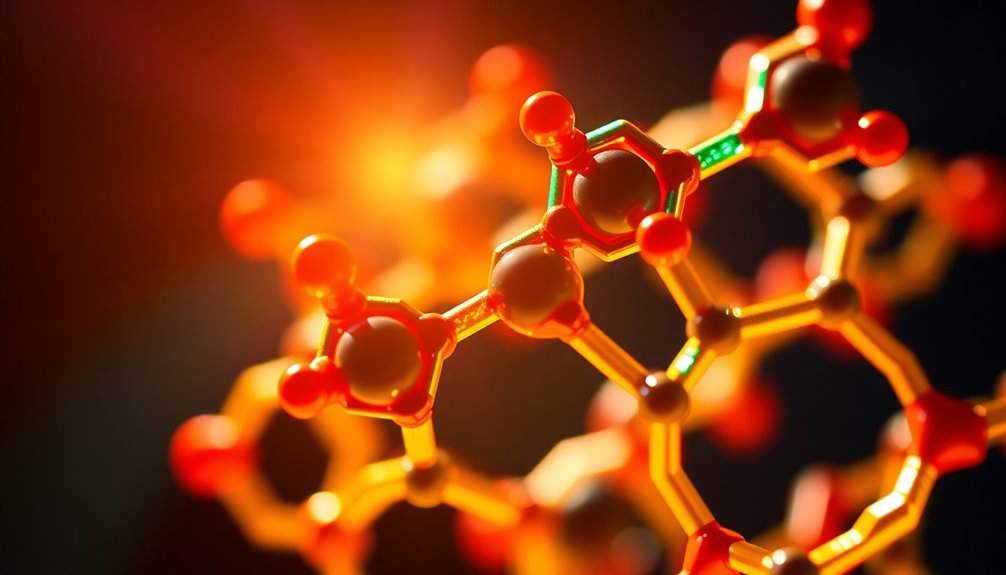
Conjugation plays an essential role in the behavior of aromatic compounds, as it enhances the delocalization of π electrons across the molecular framework. This delocalization lowers the energy gap between the highest occupied molecular orbital (HOMO) and the lowest unoccupied molecular orbital (LUMO), allowing aromatic rings to absorb UV light more effectively. As conjugation increases, you'll notice a bathochromic shift, where the wavelength of light absorbed moves to longer wavelengths.
| Property | Effect |
|---|---|
| Delocalization | Increases π electrons' mobility |
| Energy Gap | Decreases with conjugation |
| Light Absorption | Occurs at longer wavelengths |
| Bathochromic Shift | Wavelength shifts rightward |
| Reactivity & Stability | Predictable in reactions |
This characteristic is crucial for understanding their chemical behavior.
Electronic Transitions in Aromatic Compounds
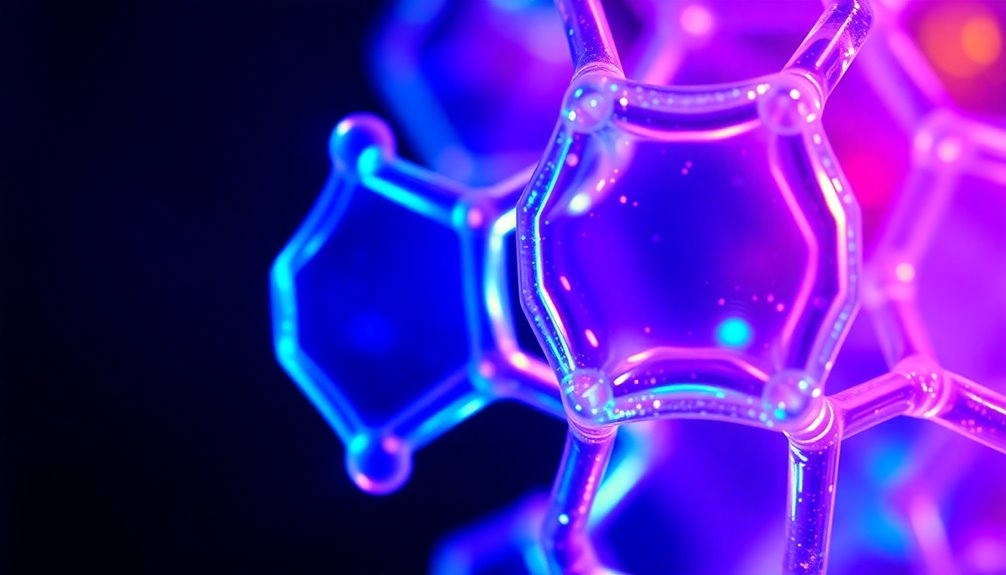
Understanding the effects of conjugation sets the stage for exploring how aromatic compounds interact with UV light.
Aromatic compounds primarily absorb UV light through electronic shifts, where electrons in bonding π orbitals jump to higher energy anti-bonding π* orbitals. The energy gap between these orbitals dictates the specific wavelengths absorbed, with larger conjugated systems having smaller gaps and consequently absorbing at longer wavelengths.
For instance, benzene shows π-π* shifts around 254 nm, while buta-1,3-diene absorbs at 217 nm due to its extended conjugation. Additionally, non-bonding electrons in these compounds can engage in n-π* shifts, enhancing their UV absorption characteristics.
This understanding is essential for applications like chromatography, where it aids in identifying and quantifying organic compounds.
Applications in Chromatography
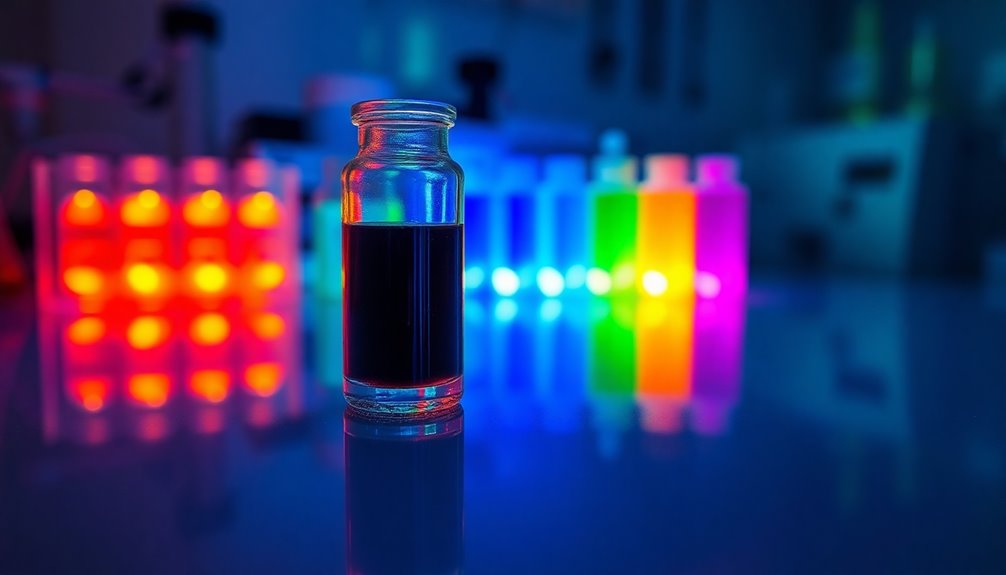
Since aromatic compounds exhibit strong UV absorption, they play an essential role in chromatography applications. Their unique electronic shifts allow for effective detection of various compounds, making it easier to differentiate closely related substances.
In UV-Visible chromatography, you can rely on the specific wavelengths absorbed by aromatic rings to enhance detection limits, even at low concentrations. This capability is significant for both qualitative and quantitative analyses, ensuring accurate measurements of concentration levels in complex mixtures.
Aromatic compounds are particularly valuable in fields like pharmaceuticals and environmental science, where precise analysis is critical. Understanding their UV absorption patterns is key to developing effective chromatographic methods, enabling you to tackle challenging analytical tasks with confidence.
Absorption Spectrum Characteristics
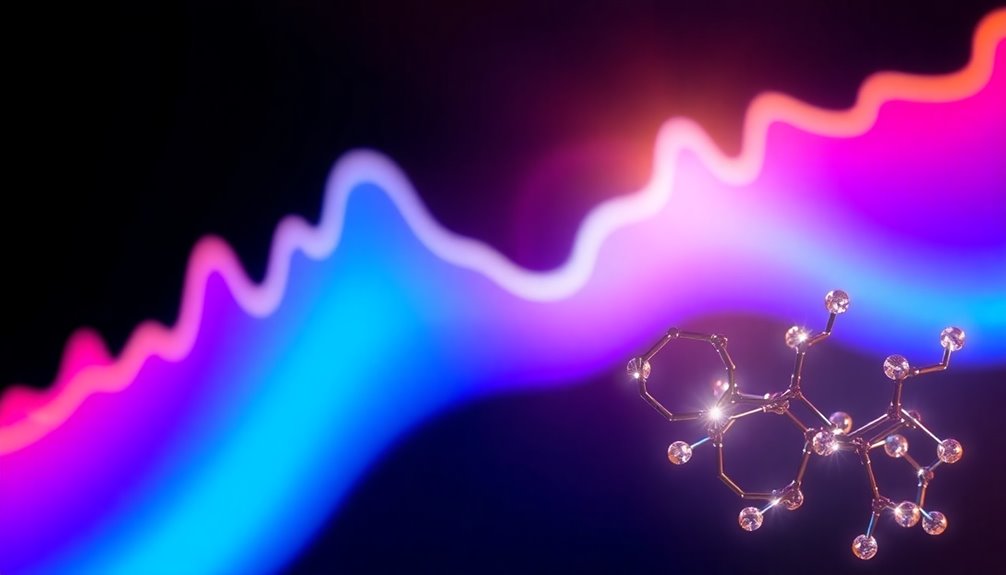
Aromatic compounds are known for their distinct absorption spectrum characteristics, which stem from their conjugated π systems. These systems enable electronic shifts between bonding π and anti-bonding π* orbitals, allowing them to absorb UV light effectively.
The absorption wavelength (λmax) varies among aromatic rings, with examples like buta-1,3-diene peaking at 217 nm. The energy required for these shifts correlates with the extent of conjugation; more conjugation leads to lower energy gaps and longer wavelengths absorbed.
Absorption peaks on the UV spectrum reflect specific shifts, such as π to π* and n to π*, with aromatic compounds often displaying multiple peaks. The intensity of these peaks indicates the amount of light absorption, with higher peaks signifying more effective absorption.
Color Perception and Chromophores

Color perception in compounds often hinges on the presence of chromophores, which are responsible for the absorption of specific wavelengths of light.
Aromatic rings serve as effective chromophores due to their conjugated π systems, allowing them to absorb UV light through electronic changes between bonding π orbitals and anti-bonding π* orbitals. The structure and extent of conjugation in these compounds dictate the specific wavelengths absorbed.
For instance, larger conjugated systems absorb light at longer wavelengths. This absorption leads to color perception; the wavelengths not absorbed determine the visible color.
Take beta-carotene: its highly conjugated system absorbs blue to cyan light, making it appear orange. Consequently, aromatic compounds can be colorless or colored based on their absorption characteristics.
Implications in Organic Chemistry
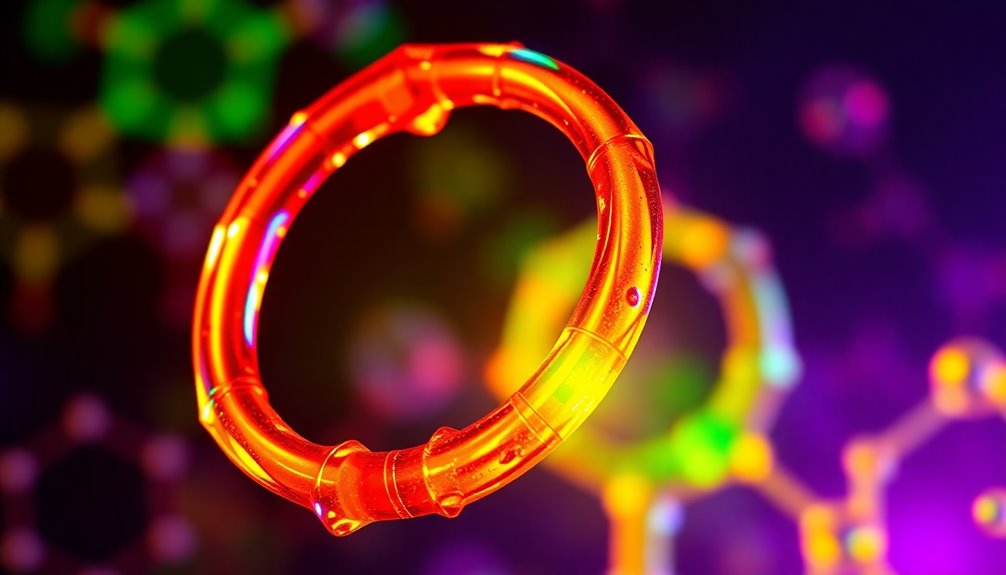
Understanding how aromatic rings interact with UV light has significant implications in organic chemistry. The presence of conjugated π bonds allows for electronic changes that result in UV light absorption at specific wavelengths.
This characteristic makes aromatic compounds essential in analytical techniques like chromatography, helping you differentiate and quantify them based on their unique absorption wavelengths.
Furthermore, the energy gap between π and π* orbitals decreases with increased conjugation, influencing the reactivity and stability of these compounds in various reactions.
By grasping these UV absorption characteristics, you can better predict the behavior of aromatic rings in designing pharmaceuticals and agrochemicals.
Ultimately, their strong UV absorption enhances detection limits, making them invaluable tools for both qualitative and quantitative analyses in organic chemistry.
Frequently Asked Questions
Why Do Aromatics Absorb UV?
You might wonder why aromatics absorb UV light. It's because their structure allows for electronic shifts.
When UV light hits these compounds, π electrons get excited from bonding π orbitals to higher energy anti-bonding π* orbitals. This shift requires specific energy, corresponding to certain UV wavelengths.
The more conjugated the system, the lower the energy gap, enabling absorption at longer wavelengths.
Why Does Benzene Absorb UV Light?
Benzene absorbs UV light because its conjugated π system allows electrons to move easily between energy levels.
When you shine UV light on benzene, electrons in the bonding π orbitals get excited to higher energy anti-bonding π* orbitals.
This change occurs at a wavelength of about 254 nm, thanks to benzene's resonance structure, which enhances electron delocalization.
This property is essential for identifying and analyzing aromatic compounds in various applications.
Why Do Aromatic Rings Fluoresce?
Did you know that around 90% of aromatic compounds can fluoresce under the right conditions?
When you expose aromatic rings to UV light, their electrons jump to higher energy levels. As these electrons return to their original state, they release energy in the form of visible light.
The efficiency of this process varies among compounds; some emit bright colors, while others mightn't fluoresce at all due to energy losses through non-radiative decay.
Why Do Molecules Absorb UV Light?
Molecules absorb UV light because their electrons shift from lower energy bonding orbitals to higher energy anti-bonding orbitals.
This absorption depends on the energy gap between these orbitals, which corresponds to specific UV wavelengths.
The presence of chromophores in a molecule plays an essential role, as they contain π bonds or non-bonding orbitals that facilitate these electronic shifts.
Understanding this process helps you analyze compounds in various applications, like spectroscopy.
Conclusion
In principle, aromatic rings are like vibrant storytellers, weaving tales through their ability to absorb UV light. This unique characteristic, driven by their conjugated structures, not only enhances our understanding of organic chemistry but also plays an essential role in various applications, from chromatography to color perception. By appreciating how these molecular structures interact with light, you're opening up a world where science and beauty intertwine, revealing the hidden magic behind the colors we see.

